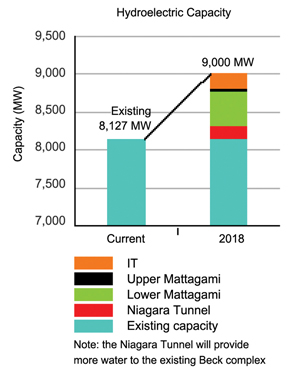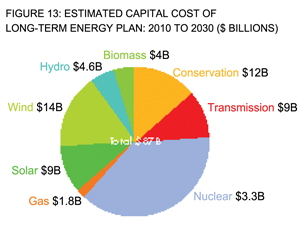
Toronto: In a wide-ranging announcement November 23, the Ontario government released a set of documents centred around a revised Long Term Energy Plan (LTEP) for the province. Branded as a “Clean Energy Revolution Leading to Jobs, Cleaner Air,” the announcement is the centerpiece of current provincial energy policy and a clear indication that the government intends to stay its present course, albeit with some minor adjustments. Ontario Energy Minister Brad Duguid said the initiative will “make Ontario a clean energy powerhouse” and “help create the prosperous economy Ontarians deserve.” Highlights of the plan include the elimination of coal-fired power generation in the province by 2014, installing 10,700 MW of new renewables by 2018 in addition to hydroelectric development, capital investment estimated at $87 billion over the next 20 years from the private and public sectors combined, and tens of thousands of new jobs. The plan is accompanied by a set of tax measures intended to soften the impact of expected rate hikes.
Comparing the initiative to the early days of Ontario Hydro, Minister Duguid pointed out that there was strong opposition to damming Niagara Falls, but it paid off handsomely in the long run: “Just as Beck did 100 years ago ... we are seizing this opportunity to power the next century with clean energy,” he said. Noting that more than 20 manufacturers have announced new investments in the past year to serve the green energy market in Ontario, a government statement says the plan will “create a vibrant clean energy economy that provides clean power to Ontario families, creates jobs, cleans up the air we breathe and supports innovation.”

The documents released on November 23 serve a number of purposes including the announcement of several specific generation and transmission decisions, the re-initiation of a regulatory review of the previous integrated power system plan, substantiation for a new financial mechanism called the “Ontario Clean Energy Benefit,” creating the context for the release of several additional new directives and regulations, public notice of a formal consultation process on a revised Supply Mix Directive, and indirectly as a policy platform for the governing Liberal Party to use in the upcoming election.
Reaction from energy sector stakeholders was generally positive. “Clarity and stability are essential in attracting the kind of long term capital Ontario needs to ensure that our electricity system continues to be reliable, flexible and increasingly clean,” said APPrO President Dave Butters. “The LTEP continues the direction the government has taken on electricity policy for some time, and it is clear about what kind of generation is expected to be in the supply mix going forward, and the capacity targets. It clarifies a number of the priorities for transmission and distribution new build and reinforcement, and it sets out clear targets for conservation and demand,” he added. Butters also praised in particular the decision to release directives on Non-Utility Generation contracts and procurement of Combined Heat and Power.

The Association of Major Power Consumers in Ontario (AMPCO) welcomed the announcement, saying the plan recognizes the importance of stable, competitive electricity rates for industry. The Industrial Conservation Initiative — a key component of the plan — creates meaningful incentives for manufacturers and other major power consumers to invest in efficiency, conserve energy, reduce costs and deliver benefits to the electricity system overall, the organization said. “Competitive electricity rates are an absolute priority for AMPCO members. The plan sets out a framework to create a reliable, economically viable electricity system for Ontario,” commented Adam White, AMPCO President. “This plan means a stable investment climate, and that means more jobs.”
The Canadian Nuclear Association (CNA) also welcomed the release. “Today’s announcement by the Government of Ontario charts the course forward for the 71,000 Canadians who work to bring the benefits of nuclear technology into our daily lives,” said Denise Carpenter, President and CEO of the CNA. For the nuclear industry the plan seems to herald the end of a period of indecision as the plan would see the refurbishment of 10 nuclear reactors and the construction of two new ones over the next 10 to 15 years. An estimated 25,000 jobs would be created from the refurbishment alone.

Advocates for distributed generation also supported the LTEP. “This plan is another huge step forward to a cleaner and more efficient power system,” said Jan Buijk, Chair of WADE Canada (the World Alliance for Decentralized Energy) and President of EPS Ltd. “[It] provides the market certainty and gives confidence to WADE Canada’s members in the decentralized energy industry to continue to pursue clean energy projects.” Decentralized energy, including combined heat and power, is an essential component of the plan that is necessary to optimize clean and renewable energy generation, WADE said. The Agri-Energy Producers Association of Ontario commented that biogas is not being employed to its full potential under the plan. The Ontario Waterpower Association voiced similar concerns about waterpower. The Ontario Clean Air Alliance praised many parts of the plan, but says the reliance on nuclear energy will prove costly, and objects to the standard offer for CHP being limited to 500 MW. Concern over the plan came from an unexpected direction: the province’s own Environmental Commissioner says the government needs to make improvements to its energy conservation programs, if it hopes to meet the LTEP’s electricity reduction targets. Gord Miller has a number of recommendations, to improve conservation programs, noting in particular that “The Ontario Power Authority should design its demand response programs to more closely coincide with times of peak consumption.” The Commissioner published a report on November 30 titled “Rethinking Energy Conservation in Ontario.”
Industry observer Tom Adams was one of the plan’s most vocal critics. He faults the plan for having too much of a predetermined emphasis on wind and solar, and the associated new transmission. He writes that the plan “contemplates converting the 1970s vintage coal plants at Nanticoke and Sarnia to gas. These converted coal plants would burn at least 50% more gas per unit of delivered electricity as compared to the Oakville project just cancelled.” Adams also objects to the revised daily time frame for off-peak prices as likely being designed to respond to voter preferences rather than to system needs.
The plan continues a number of previously-established aspects of current provincial energy policy including the Feed-in Tariff program, a major emphasis on energy efficiency, community power and Aboriginal involvement in power development decisions affecting their communities. It also asked the OEB to establish a set of principles and objectives for development of the smart grid in Ontario. LDCs would be expected to develop smart grid plans according to this framework, now formalized in a directive to the OEB.
Specific provisions in the plan include the following:
1. A natural gas fired power plant in the Kitchener-Waterloo-Cambridge region.
2. Two new nuclear units at the Darlington site, totaling 2,000 MW.
3. Hydroelectric capacity is to go from its present level of 8127 MW to 9000 MW by 2018. The Lower Mattagami project expansion represents about 440 MW of this amount, the largest hydro project in Ontario in many years.
4. In transmission, investments of approximately $2 billion are planned over the next seven years, focusing on five priority transmission projects. In addition to the Bruce-to-Milton line, these projects will enable approximately 4,000 MW of additional renewable energy.
5. Renewal of contracts with Non-Utility Generators and new contracts for power from CHP facilities. (See “New Directives,” page 11, for details.)
Pretty well all of the above were parts of the previous Integrated Power System Plan, although there have been some adjustments in sizes and timing.
With a directness rarely seen in Ontario, the government openly acknowledges that increases in energy prices are expected: “To keep the lights on with energy powered by clean sources, residential and small business electricity bills are forecasted to increase by 3.5 per cent annually over the next 20 years. Industrial rates are forecasted to increase by 2.7 per cent annually over the same timeframe.” At least eight distinct measures are being used to moderate the impact of the expected price increases:
1. The Ontario Clean Energy Benefit
• Provides a 10 per cent benefit to help consumers manage rising electricity prices for the next five years. Paid for directly out of the public accounts.
2. The Ontario Energy and Property Tax Credit
• Up to $1,025 for eligible Ontarians paid quarterly, beginning in 2011.
3. The Northern Ontario Energy Credit
• A new, permanent energy credit designed to help families and individuals in the North who face higher energy costs.
4. Time of Use pricing
• Reduced rates for shifting consumption to off-peak periods
5. Regulated Price Plan (RPP)
• Operated by the Ontario Energy Board for several years, a means of smoothing the impact of sudden increases in rates
6. A new emergency energy financial assistance fund for low income consumers
7. The Energy Consumer Protection Act, 2010, which is expected to ensure that consumers receive accurate price disclosure from all energy retailers before they sign contracts.
8. For industrial consumers, there are a number of programs designed to help them manage electricity costs including reallocation of the Global Adjustment and the Northern Industrial Energy Rate Program, which provides electricity price rebates for qualifying northern industrial consumers who commit to an energy efficiency and sustainability plan. On average, the program reduces prices by about 25 per cent for large facilities. The OPA has a number of other programs for industry including the Industrial Accelerator program and the Industrial Conservation Initiative.
After the Supply Mix Directive review is complete in January 2011, the plan will move to the Ontario Power Authority for further refinement. It is expected that the plan will be submitted by the OPA to the Ontario Energy Board in 2011. A final decision on the plan from the OEB is expected in 2012.
The current draft of the Long Term Energy Plan document is available for download at this location: http://www.mei.gov.on.ca/en/pdf/MEI_LTEP_en.pdf.
